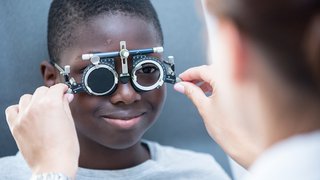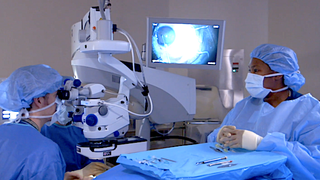Causes of Strabismus
Most strabismus results from abnormal neuromuscular (including brain) control affecting nerves that control the eye muscles. We do not completely understand the underlying causes of this neuromuscular problem. Less commonly, a problem with the actual eye muscle can cause strabismus.
The main risk factor for developing strabismus is a family history of any type of the condition.
Strabismus often occurs in children who are otherwise completely normal.
Other possible causes include:
- Brain disorders such as cerebral palsy, hydrocephalus, and brain tumors
- Down syndrome
- Extreme refractive error
- Stroke or other vascular problem (in arteries or veins)
- Thyroid eye disorders such as Graves’ disease
- Trauma to the eye or brain
- Vision loss from any eye disease or injury
Symptoms of Strabismus
Some symptoms of this condition do not occur constantly. Also, children might not realize that they are experiencing double vision.
Symptoms of strabismus can include:
- Crossed eyes
- Difficulty with depth perception
- Double vision
- Eyes that look in different directions
- Eyes that do not move together
- Vision loss
Diagnosing Strabismus
It is normal for a newborn’s eyes to move independently and, at times, even cross. However, by three to four months old, an infant should be able to focus on objects, and the eyes should be straight. Parents who notice that their child’s eyes are turning in different directions or that the child’s eyes cannot focus on objects should consult their pediatrician.
Early detection and treatment of strabismus can prevent permanent visual impairment. At UT Southwestern, we begin the evaluation with a complete eye exam that includes:
- Vision test
- Sensory motor exam to check the alignment and eye muscle movements
- Cycloplegic refraction tests, with dilating eyedrops, to check refraction without the eye being able to autofocus
- Slit-lamp exam to look at structures inside the eye
- Fundus examination using a specialized retinoscope to show details of the retina
Treatment for Strabismus
The goal of strabismus treatment is to improve eye alignment, which allows for the eyes to work together better (achieving binocular vision).
At UT Southwestern, we thoroughly evaluate patients to determine the best treatment plan. Treatment might involve eyeglasses, eye exercises, use of a prism in glasses, and/or eye muscle surgery.
The underlying problems associated with strabismus (including amblyopia, ptosis, and cataract) are usually treated prior to eye muscle surgery, especially in children.







